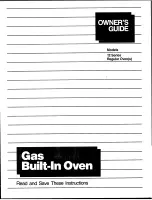
32
K.2
Maintenance intervals
The inspection and maintenance intervals depend on the
actual machine operating conditions and ambient conditions
(presence of dust, damp, etc.), therefore precise time intervals
cannot be given. In any case, careful and periodical machine
maintenance is advisable in order to minimise service
interruptions.
K.2.1
Preventive Maintenance
Preventive Maintenance reduces downtime and maximizes
machines efficiency.
Customer Care Service can provide advice on the best
maintenance plan to be purchased based on the intensity of
use and the age of the equipment.
It is advisable to stipulate a preventive and scheduled
maintenance contract with the Customer Care Service.
K.3
Informations for maintenance
During service, repair and maintenance work, distractions and
stress factors must be avoided.
As such, unauthorised persons must be kept away from the
appliance.
Servicing may be not carried out on ships at sea.
The warning and information notices fitted to the appliances
must be obeyed by specialist and customer service staff and
must not be removed or altered.
IMPORTANT
• Repairs and service on the appliances must be
carried out when heating elements have cooled
down.
• After completion of the maintenance and repair
work, the service technician must carry out
checks to ensure all operating modes of all
functional and safety components are in accord-
ance with the operating instructions.
K.4
Repair and extraordinary maintenance
NOTE!
Repair and extraordinary maintenance have to be
carried out by specialised authorised personnel,
who can ask the manufacturer to supply a service
manual.
K.5
Periods of non-use
If the appliance is not going to be used for some time, take the
following precautions:
• Close the valves or main switches ahead of the appliances;
• Go over all stainless steel surfaces vigorously with a cloth
moistened with paraffin oil in order to create a protective
film;
• Periodically air the premises;
• Have the appliance checked before using it again;
• For the electric heated models: switch the machine On at
the minimum rate of heat for at least 45 minutes; this will
allow moisture/humidity accumulated into the heating
elements to evaporate without damaging the elements.
• Never store the appliance where the temperature can drop
below 0
℃
/ 32
℉
.
• Clean and dry the appliance thoroughly to avoid corrosion.
• Always leave drawers and doors open to ensure the oxygen
can circulate.
K.6
Changing the batteries
Units are delivered with battery-powered ignition.
If the indicator lights red when you turn on the machine, you
need to change the batteries for the igniter and indicator.
To access the batteries, unscrew the control panel (refer to F.3
Accessing the appliance’s internal components
).
You need 4 x 1.5V C batteries.
L
TROUBLESHOOTING
L.1
Introduction
This list is just a short description; for detailed information, please read the service manual.
Should none of the measures listed below resolve the fault or if an error occurs that is not described here, disconnect the appliance
from the mains supply (gas, water, electricity) and immediately contact the Electrolux Professional Customer Care Service.
L.2
What to do if
Problem
Cause
Solution
Main burner
No or inadequate flame
Shut-off valve tap is off
Open the shut-off valve tap
Pilot burner
Flame goes out when ignition control
knob is released
The ignition control knob is not held
down for longer
Hold down the control know for at least
20 seconds
M
MACHINE DISPOSAL
WARNING
Refer to “
M.1
Procedure regarding appliance
dismantling macro operations
Before disposing of the machine, make sure to carefully check
its physical condition, and in particular any parts of the
structure that can give or break during scrapping.
The machine's parts must be disposed of in a differentiated
way, according to their different characteristics (e. g. metals,
oils, greases, plastic, rubber, etc.).
Different regulations are in force in the various countries,
therefore comply with the provisions of the laws and compe-
tent bodies in the country where scrapping takes place.
In general, the appliance must be taken to a specialised
collection/ scrapping centre.
Dismantle the appliance, grouping the components according
to their chemical characteristics, remembering that the com-
pressor contains lubricant oil and refrigerant fluid which can be
recycled, and that the refrigerator components are special
waste assimilable with urban waste.
Содержание thermaline MBQI HCPO Series
Страница 1: ...Static Gas Oven EN US Installation and Operating manual 599A18800 82 8131 11 2020 12 ...
Страница 34: ......
Страница 35: ......
Страница 36: ...Electrolux Professional AG Allmendstrasse 28 CH 6210 Sursee www electroluxprofessional com ...





































